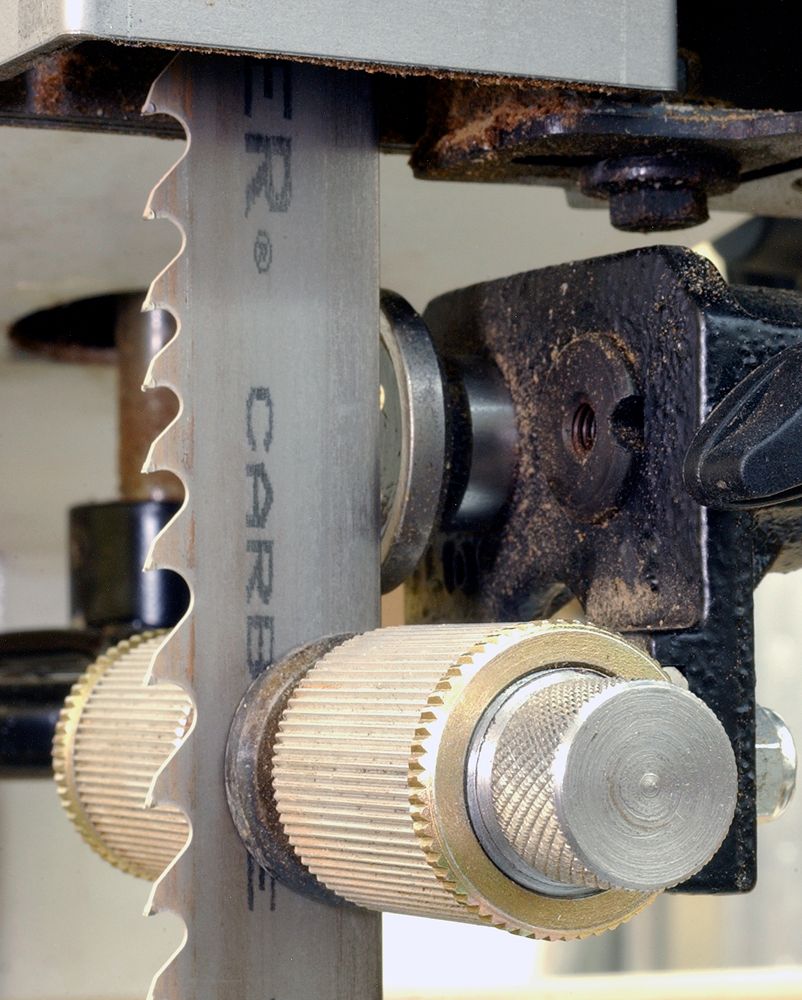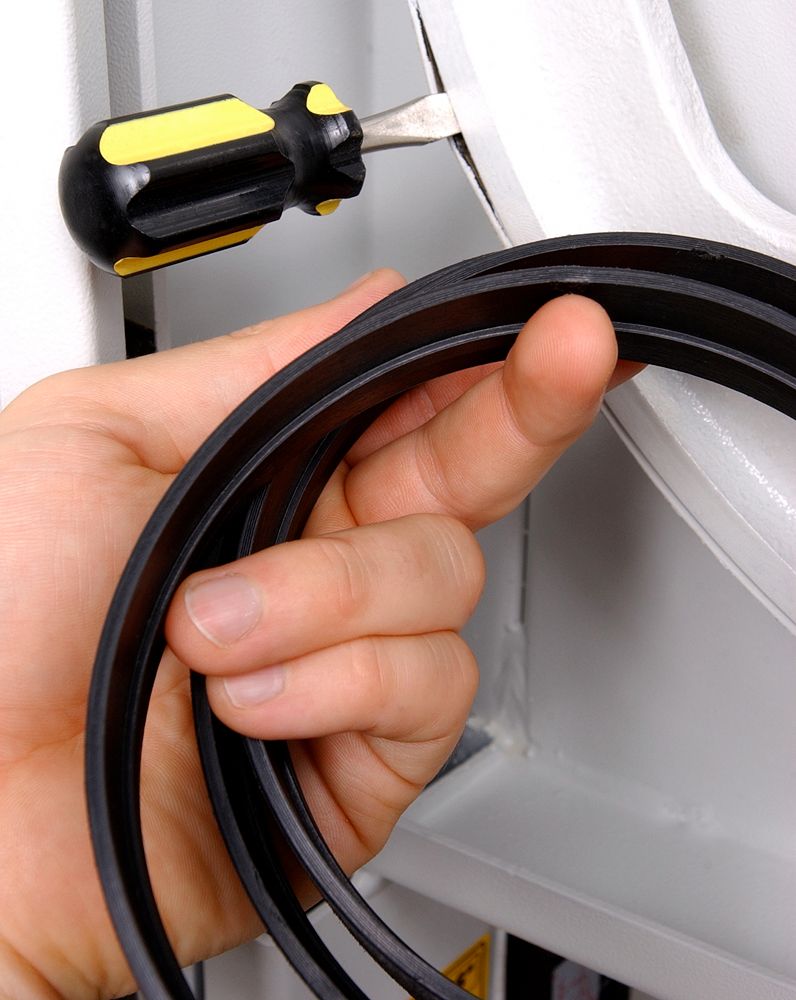
-
So, the collective wisdom, is: it seems like the 30-35K tension, although high, is probably not the sole cause of the break.
Also, detensioning @ the end of the day is more for the machine (and I fully agree that in fact was in my mind originally, before the blade break.)
So, I had a Rikon 16" before, and then wanted something "better". Researched and got the MM-16 cause of the triple beam spine (Eric, please feel free to correct me, as it has been some time.) As Eric also knows, my only gripe was I had to build a rolling platform, to raise the machine about a foot.
I must say that the main reason I got the MM-16 is the beam strength (correct term?) as i was into veneer at the time. So, you might say I am invested in the concept of having huge amounts of tension on the blade......
Still need to call Laguna and ask them about tensioning.
**Does anybody else actually use a tension gauge?** (I am going to create a new post and ignite the tension question)
-
Leaving the blade tensioned overnight wouldn't have been the culprit. As Ian has said fatigue failures are due to cycles not time, so while it may have been a fatigue failure due to being run at too high a tension, being left at a high tension overnight wouldn't matter. The number of cycles produced by the retensioning/detensioning is also highly unlikely to be an issue for a weekend woodworker, as even after 10 years you'd only have accumulated 1000 cycles.
35ksi seems like an awfully high stress level for a blade to me. That is a net section stress and when multiplied by the stress concentration factor caused by the gullet you'll be at 70-100ksi, which is a significant stress even for a good steel. Although the blade will be under constant tension while running, small factors like any camber on the wheels could cause cyclical loading on the blade and cause the fatigue failure.
There isn't a real reason to detension a saw at night for the blade, it may however have some benefit for the bandsaw tires.
-
For sure there's the potential for all sorts of peculiarities (as in much higher than nominal stress levels) to arise once the camber, tooth gullets, tracking, vibration, saw set up and the rest are factored in.
The obvious reason for detensioning is to head off the possibility that the bandsaw tyre might take a set and develop a flat or other irregularity - but quite a bit depends on the stress level and the polymer used, and both may vary a lot. Plastics in general are prone to taking a set/plastic deformation under fairly moderate sustained stress levels. Which again is the principle - but it'd need knowing the specific polymer/plastic and calculating the maximum compressive stress to take an informed shot at whether or not it might be a real issue or not.
I seem to remember some claiming it's not been a problem on their saw, others that it has...
-
PS thought just prompted by the tension gauge thread. Judging by the fits it caused an old lighter duty (still claimed to be 'professional') saw i had due to frame flexing - a deep cut, tough wood, heavy feed and coarse teeth all have the ability to significantly add to the tension in the blade too - this on top of static tension and all of the other factors we've discussed.
There's tables about somewhere on cutting forces in wood which would make it possible to estimate this factor if somebody wanted too.
The bottom line message that comes across has to be that even though 35,000psi static tension is well below the likely fatigue limit of maybe 60,000psi for a tempered high carbon bimetal or carbide blade band that there's an awful lot of not necessarily obvious additional factors simultaneously stacking up on top of each other to push the actual working stress up towards or beyond the latter limit. Especially when stress concentration effects caused by nicks and notches have the potential to multiply the static stress several times...
Last edited by ian maybury; 12-17-2014 at 11:04 AM.
-
David, correct: All the Centauros (MM-series bandsaws...) have three steel beams for the spine...

This is just my opinion, so feel free to agree or otherwise: I feel like the whole "fatigue cycle"-thing may be more an issue on paper than in the real world. At least in regards to Lenox carbide blades and at least in regards to Centauro bandsaws. I say that because I have probably shipped as many 1.0" Lenox Tri-Masters as anyone (figure probably in the 100's...) to MM16/S400P owners, the first thing I tell them is to de-tension at the end of each day, and have yet to hear back from one owner who had one of those blades break prematurely. And that's going back 10 years. In the Austin shop, we had TRi-Masters that went on and off the machine a bizillion times and showed no evidence of starting to fail. I've killed Tri-Masters from cutting too green of wood but never from "on and off the machine a lot".

On the other hand, I have spoken to owners who I am pretty sure fatigued their blades and also deformed their tires by leaving carbides under tension for extended periods of time. Bear in mind that my experience is solely in regards to Centauro saws. So, maybe these machines are able to stretch out a carbide blade enough to kill it like that? I snapped an almost brand new Tri-master once from over-tension on an MM16 and it was cutting perfectly until the moment the blade let go. Regarding tires, the Centauro snap-in ones do seem a lot more pliable to me than than the tires on ACM or Agazzani saws, so it's possible that the material they are made of could deform more readily. I've never been interested in testing that, since it's so easy to just de-tension an MM16 at the end of the day.

Keep in mind that I am neither an engineer nor a metallurgist but based on my experience, you should de-tension your blade at the end of the day and also, if you take good care of your carbide, it should last a long, long time. "Fatigue cycle" may indeed be a factor for some machine and blade combinations but I have yet to see it in hundreds of 16"/400mm saws sold with carbides over the years.
Erik Loza
Minimax USA
-
I had not thought about the deformation of the tire. That alone is a good reason for me to detension at end of day. If I was doing BS work every day, I would think this would not be as big a factor.
-
Agree (as on the other thread) that de-tensioning in as much as its necessary in the case of a given tyre type and material is likely about protecting the tyre - polymers/plastics in general have some tendency to take a set if loaded for prolonged periods.
As in most things mechanical there seem definitely to be people about that bust blades Erik, and lots more for whom it never happens - so it's probably a matter of our taking on board that at least reasonable care is necessary.
The one that's an absolute given is that if a saw can through misuse/wrong settings (if only on a narrow one which pretty much has to be possible) load a blade heavily enough to break it, then by definition it can if misused load a blade heavily enough that it can likely suffer fatigue failures.
Another theoretical but likely practically relevant thought. Chances are that frame/saw chassis that's not all that rigid vs the blade that's being run, and especially one that twists out of alignment as opposed to deflecting in the line of the blade will have a greater tendency to break blades/will all else being equal run into problems at a given wheel size before another.
There's the potential for if nothing else vibration in the form of 'nodding' of the cantilever (which would induce lengthwise 'tugging' in the blade), but if the chassis twists out of line as it loads up (but the camber maintains tracking) as well then not only may this occur - it'll probably also load one edge of the blade much more heaviliy than the other. Likely to be especially dodgy if that happens to be the toothed side.
The problem as at the start is to use what is a theoretical possibility to accurately predict reality. The one thing that seems to be pretty clear (judging by comments on forums) is that high end saws like e.g. the heavy duty Italians don't seem to run into problems unless something isn't right about the blade or the set up…....
Last edited by ian maybury; 12-17-2014 at 4:46 PM.
-
The most common complaints I hear from owners seem to be related to choosing the wrong blade for the job or trying to make one or two different blades do everything on all species/moisture levels of wood. Those issues far, far outweigh actual defects in either the blade or the machine. At least in my experience.
Erik Loza
Minimax USA
-
You've i'm sure seen a lot more than me Erik, but poor blade choice has to be another variable so far as the potential for blade overloading/fatigue is concerned.
It seems to come up time and again for example that running blade that's of too fine a tooth/too small a gullet for a given depth of cut results in a scenario where the gullet ends up clogged with sawdust before the tooth reaches the end of the cut - with the result that the dust spills out into the kerf/the gap between the saw band and the timber. Leading potentially to very high levels of drag/friction/jamming, and lots of heating - and the possibility of over tensioning/over stressing/overheating/annealing and weakening/fatiguing the blade and even overloading the motor.
The green wood you mention is probably a similar scenario - one where the chips don't necessarily cut cleanly and or get carried out of the cut as easily as say dry sawdust...
There was always a lot of talk of the usefulness of skip tooth blades in this situation, but i guess the very deep gullets on carbide tipped blades like e.g the Woodmaster CT may along with the ability of the block shaped teeth to a degree to plane the sides of the cut may also at least partly explain why they seem to cut so freely.
Another cumulative factor to load up the blade even more, and cause problems which are not the fault of the saw or the blade...
-
Just a PS. These guys (Vollmer) make bandsaw blade grinding machines, and have some interesting things to say about how correct sharpening can extend the fatigue life of bandsaw blades: http://tiny.cc/nt34qx - among them that regular full tooth grinding is advisable. This because it removes material that has already started to (micro) fatigue crack in the gullets. Presumably that in doing so it (?) to some degree anyway zero resets the cycle count on blade...
 Posting Permissions
Posting Permissions
- You may not post new threads
- You may not post replies
- You may not post attachments
- You may not edit your posts
-
Forum Rules




 Reply With Quote
Reply With Quote



